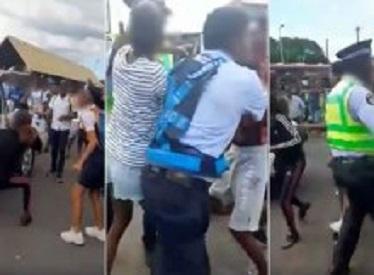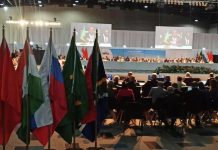Africa-Press – Mauritius. A few years ago on a flight from Los Angeles to Chicago where I would be in transit, I was seated next to a pleasant young lady. She was White – an important distinction in America – and as we got to talking I asked her whether she was going on holiday to Chicago.
Yes and no, she answered – as a matter of fact she was: she was studying in LA, but going home for the summer break. She told me LA was OK for studies but she loved her home city of Chicago.
Like practically all Americans for whom their country is the whole world, she had never heard of Mauritius, and for the umpteenth time while travelling I had to explain that the little dot in the Indian Ocean was actually a country complete with roads and airport and a government, etc.
The first time I heard anything substantive about Chicago was in 1979, in a medical context. I was attending a revision course for my final surgery examinations at the Royal College of Surgeons in Edinburgh.
The surgeon who came to lecture on abdominal injuries was dressed like a cowboy: worn jeans, a leather vest complete with fringes, large belt and, to boot, he had mild jockey legs that sported cowboy style footwear.
It turned out that he had spent a year as a Fellow at the Cook County Hospital in Chicago which, he informed us, was the most violent city in the world.
Cook County Hospital handled the bulk of the human consequences of that violence which often included catastrophic gunshot wounds to the abdomen, of the kind seen more during war than under civilian conditions.
Crime: American scourge After so many years Chicago swam into my orbit again as it were – in the form of a book review in a recent copy of the English paper The Economist, under ‘Crime: American scourge’.
The book is by Adam Kotlowitz: ‘An American Summer: Love and Death in Chicago’. As the paper points out, ‘Mass shootings attract plenty of attention. But ordinary violence causes far more damage to the most vulnerable people’.
A resident of the city, Mr Kotlowitz published a first book on this ‘painful subject’ of violence in the early 1990s when killings were at their peak, and returns to the subject a generation later as he ‘immersed himself in the lives of two brothers, Lafayette and Pharaoh, as they became young teenagers… growing up in public housing, threatened by gangs and guns’.
Clearly, this is not the Chicago where the young student I met on my flight lives. Rather, it’s the Chicago of South Side, such as Bronzeville – once home to artists such as Louis Armstrong and Duke Ellington – where, despite becoming ‘safer in the past few years’, crime still festers at levels ‘unthinkable in richer (and whiter) places’.
The Oxford English Dictionary defines ‘scourge’ as ‘a person or thing seen as punishing esp. on a large scale (the scourge of famine; Genghis Khan, the scourge of Asia)’.
By this definition there are any number of ‘person’ scourges that we can identify from the past and our own times, but we will focus on ‘thing’ scourges in this article, namely violent crime which is certainly not the prerogative of America as The Economist article might suggest.
However, since that country relentlessly projects itself on the world stage, inevitably the good, the bad and the ugly (which was the title of a movie made, where else, in Hollywood) get as much visibility.
Comparisons therefore tend to be made with its metrics and paradigms as reference. And where violent crime is concerned, Chicago tops, such that some ‘observers liken the neglected districts in the South and West Sides of the city to war zones’.
Nearly 4000 people are shot and wounded every year – one every two hours – and many end up paralysed. Mr Kotlowitz notes that ‘in the past 20 years over 14000 people have been murdered in the city. Again he sets out how sudden deaths, injuries and constant dread cut apart the fragile lives of the most deprived.
Citing the cases of near-random victims, such as the ‘girl hit by a stray bullet from a shootout’, the author notes that ‘many parents take out life insurance policies on their children’, “fearing the cost of a funeral”.
’ We probably haven’t reached that stage here. Nevertheless we have reason to be worried, given the different types of crimes that are reported daily and the official statistics published. Chicago has a population about twice that of Mauritius, at 2.7 million.
Its homicide rate is a metric of interest to us; for the year 2016, at 23.8 (per 100,000 population) compared to 2.6 locally, that is, after correcting for population size, it is about four and a half times ours.
But that is no consolation, for on all other counts our figures do not give a vastly better picture than Chicago. However, I must point out here that, save for homicide, the classification categories used by the US are different from the UN ones which we use, and therefore it is not easy to make direct comparisons.
This will require a more detailed analysis, but broadly it appears to me that the estimates are fairly comparable except, as pointed out, for homicide. Shifting nature of violence
In any case statistics only tell part of the story, which is more complete when the types of crime committed and arms and methods used are taken into consideration. The write-up about Chicago refers to the ‘shifting nature of violence’, which is also our experience though it is different from Chicago’s.
For example, whereas there the easy access to guns makes it the preferred weapon in many crimes, here the ubiquitous cutter has become notorious for its availability and use by criminals. Beatings among schoolchildren, who often gang up to assault one of theirs, causing damaging injuries, have been reported more frequently than before.
Another change that has taken place is that whereas earlier such incidents used to take place in the school compounds, increasingly the setting is at the bus stops or terminus, la Gare du Nord having acquired a certain notoriety in this regard.
And the latest novelty was of course schoolgirls (!) seen to take to aggressing policemen. This forms part of another worrying aspect of the local scene: the ‘youthification’ and feminisation of violence.
Besides schoolchildren, a number of bands of youngsters some barely out of their teens have been busted by the police, and if my memory serves me right one such band or gang was led by a boy as young as 13 or 14 years old.
And there are burglar gangs which have women members – surely a frightening development! We have reason to be immensely worried and ask: where is our society going!
There are no easy answers on how to cope with all the kinds of violence that we face, but the role that we adults have in triggering and perpetuating them is a paramount factor that we have to pay due attention to, especially as regards our behaviours both privately and professionally.
We are expected to be ‘examplars’ to our youth, but are we? The parade of high-fi, seemingly respectable personalities who were summoned to appear before the Drug Commission Enquiry – what impression will that leave on our youth?
Curbing crime rates, shunning violence, improving society is ever a work in progress in which we all have a stake and must contribute in whatever capacity we can to supplement more formal measures by legal and regulatory bodies, and that must also be regularly revisited and updated. Letting down our arms is not an option if we want a saner and safer society.
For More News And Analysis About Mauritius Follow Africa-Press







